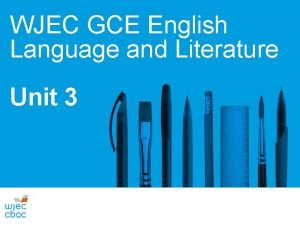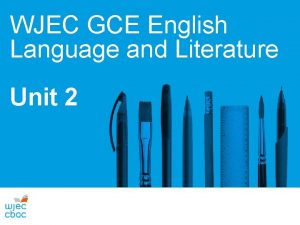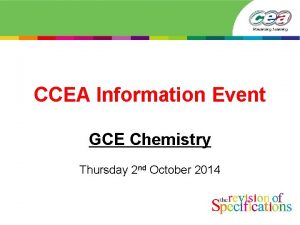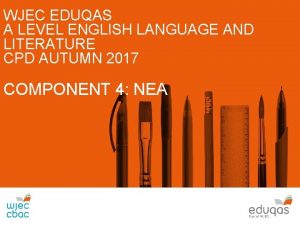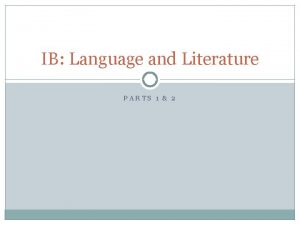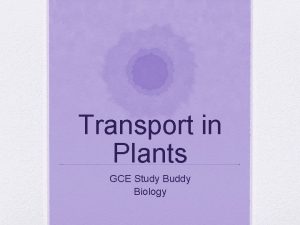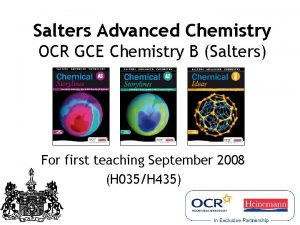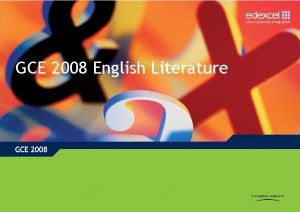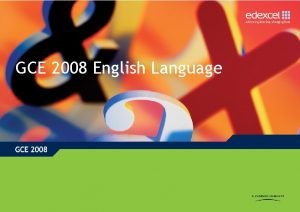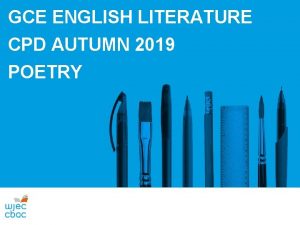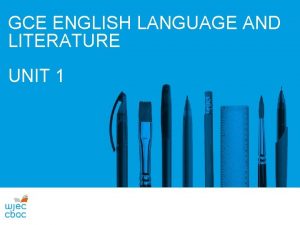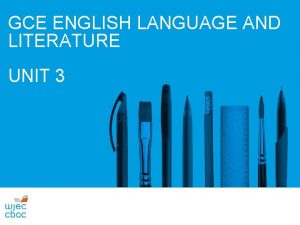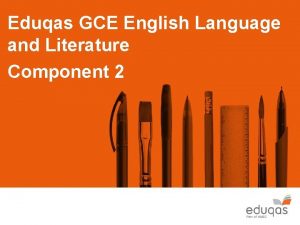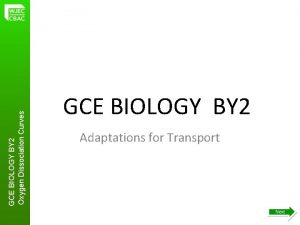GCE ENGLISH LANGUAGE AND LITERATURE UNIT 2 Unit




















- Slides: 20

GCE ENGLISH LANGUAGE AND LITERATURE UNIT 2

Unit 2 Overview Section A: Post-1900 Drama Two questions • One extract based question • 1 question based on the whole play Section B: Non-Literary Texts • One essay question from a choice of two

Unit 2 Overview Section A, part (i): • Extract – 25 minutes (5 reading and planning / 20 writing) AO 1 (5) AO 2 (20) AO 3 Section A, part (ii): • Whole play – 35 minutes (two episodes from whole play) AO 1 (10) AO 2 (10) AO 3 (15) Section B: • Whole text (candidates should aim for 3 -4 episodes) AO 1 (20) AO 2 (15) AO 3 (25)

Unit 2 Issues from 2019, Section A Key Points: • Timed exercises in class are clearly beneficial • Only discuss the set extract in part (i) • *Avoid discussing the set extract in part (ii)* • Candidates need a range of linguistic and literary terminology • Try not to write more than two pages for part (i) • Quotations from the text MUST be used to support their argument

Unit 2 Issues from 2019, Section B Key points: • Spend a short period of time selecting the most effective episodes for discussion and plan the response with context in mind • Avoid narrating/describing the text. Follow S/E/A and include at least one term for each quotation, which must be specified • 3 or 4 well chosen episodes are far more productive • Technical accuracy and correct spelling is essential, as is the use of standard English • Aim for sufficient coverage of the whole text.

Unit 2 • Develop understanding of structure and organisation of responses to questions on whole texts • Section A part (ii)—AO 1 AO 2 AO 3 • Section B—AO 1 AO 2 AO 3

Unit 2 Section A part (ii) • ‘Explore how Williams presents male dominance in 1940 s America in at least two other episodes from A Streetcar Named Desire’ • Extract question based on Scene 10 when Stanley overpowers Blanche • What questions do candidates need to ask themselves when selecting two episodes from the whole play? (5 mins)

Unit 2 Potential Questions • Which of the male characters are suitable/interesting for discussion? • Is there any scope/necessity to discuss female characters? • How is context relevant to this essay? Which elements? • Which episodes are most effective for the argument I wish to present?

Unit 2 Essay Planning • Range of potential questions specific to your play • Generic ideas/topics across all genres • Candidates should have a ‘Bank’ of material from which to draw • Still need to use planning questions and the text to help them select

Unit 2 Section A part (ii): Structure • Relatively brief overview which outlines chosen episodes and discusses the relevance of contextual points • Episode 1 following S/E/A and using terminology each time a quotation is used, and integrating context • Episode 2 following S/E/A and using terminology each time a quotation is used, and integrating context • Brief conclusion

Unit 2 Section A part (ii): Structure • Two well selected Episodes, discussed in detail, is far more effective and better time management than multiple Episodes • Allows for thorough probing of language and context • Demonstrates maturity of thought and argument (AO 1)

Unit 2 Section B: Introductions • Provided some real issues for examiners this year • Many were meaningless and contained irrelevant biographical information • Did not give any indication how the candidate would answer the question • Did not address context in any meaningful way

Unit 2 Example 1 In Truman Capote’s ‘In Cold Blood’ family is presented in many ways unfortunately some in bad ways even Capote acts like family with Dick and Perry which is why in the epigraph he talks about mercy as he wants people to give them mercy through the book. Ø Look to reward!

Unit 2 Example 1 • Look to reward! • All one sentence (AO 1) • Limited contextual reference (AO 3) • Very brief reference to Capote’s attitude (AO 2) • Limited indication of episodes to be discussed or outline of argument

Unit 2 Example 2 ‘In Cold Blood’ is a true-crime fiction that was published in 1965. The novel is based on the brutal murder of the Clutter family in 1959 by Dick Hickock and Perry Smith. The novel is written in the omniscient narrative style and it is clear that Capote favoured Perry. Throughout the novel, there are three main families that I will look at and these are the Clutters, the Hickocks and the Smiths. There are many choices that Capote made in order to show a different presentation for each family. Ø Look to reward!

Unit 2 Example 2 • Gives some indication of Episodes / Line of Argument (AO 1) but doesn’t address what Capote might be suggesting about importance (or not) family life • First part not entirely relevant, but some awareness (AO 3) • Use of first person indicates lack of formal style

Unit 2 Example 3 Capote’s non-fiction novel, ‘In Cold Blood’ is a journey through a case involving the murder of an innocent family in Holcomb. As the title suggests, the murderers we follow throughout the novel are indifferent on accounts of their actions yet as the novel continues we are able to observe how family life can affect an individual, from whether they live a carefree life, or one of violence and sin. We follow two individuals, Perry and Dick, fuelled by the greed of mankind and the promise of luxury. The two have extremely different personalities which have been formed due to their family life which we see as ‘In Cold Blood’ continues, and are able to compare this with the almost perfect nuclear family Capote presents with the Clutters.

Unit 2 Example 3 • Engages with question and gives an indication of Line of Argument (AO 1) • Comments on contextual point and the potential comparisons it invites (AO 3) • Addresses attitudes of characters (AO 2) • Not perfect, but…

Unit 2 What makes an effective Introduction? • Demonstrates evidence of planning and careful selection of Episodes (10 minutes) • Identifies a Line of Argument for the question—why this concept/idea is important in the text • Addresses elements of context and its relevance • Uses an academic register • No more than half of a page in length

Unit 2 Task Using the information from the three examples for In Cold Blood, write the introduction for the question Discuss how Capote presents family life. • Think about additional/unusual families • Think about different contextual points to include
 Unit 3 english language
Unit 3 english language Wjec gce english literature
Wjec gce english literature Ccea clarification of terms
Ccea clarification of terms Ccea gce health and social care
Ccea gce health and social care Eduqas english language a level
Eduqas english language a level Are english language and literature separate gcses
Are english language and literature separate gcses Eduqas a level english language and literature
Eduqas a level english language and literature Ib english language and literature part 3
Ib english language and literature part 3 Edexcel english literature paper
Edexcel english literature paper Cut is the branch that might have grown explanation
Cut is the branch that might have grown explanation Gcestudybuddy
Gcestudybuddy Ccea gce chemistry practical support
Ccea gce chemistry practical support Cashflow1
Cashflow1 Gce professional business services
Gce professional business services Ccea gce chemistry practical support
Ccea gce chemistry practical support Ccea a level business studies
Ccea a level business studies Cummins gce
Cummins gce Seven basic si units
Seven basic si units Ccea gce physics
Ccea gce physics Tokyo gce
Tokyo gce Gce bayreuth
Gce bayreuth
